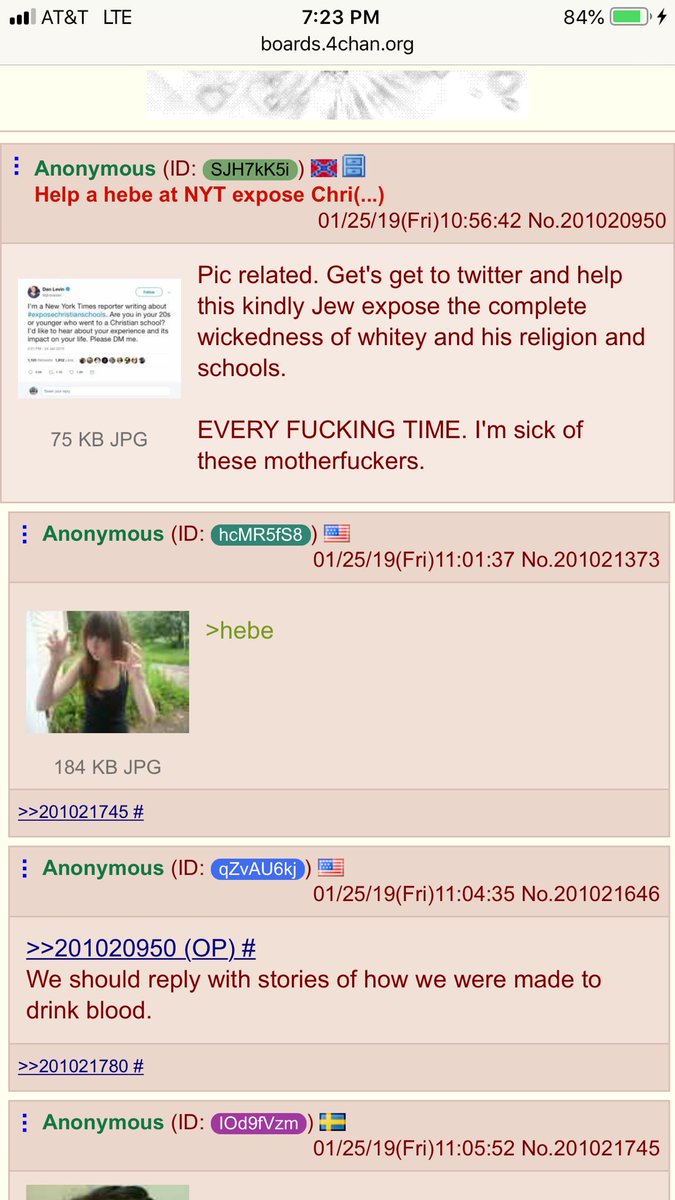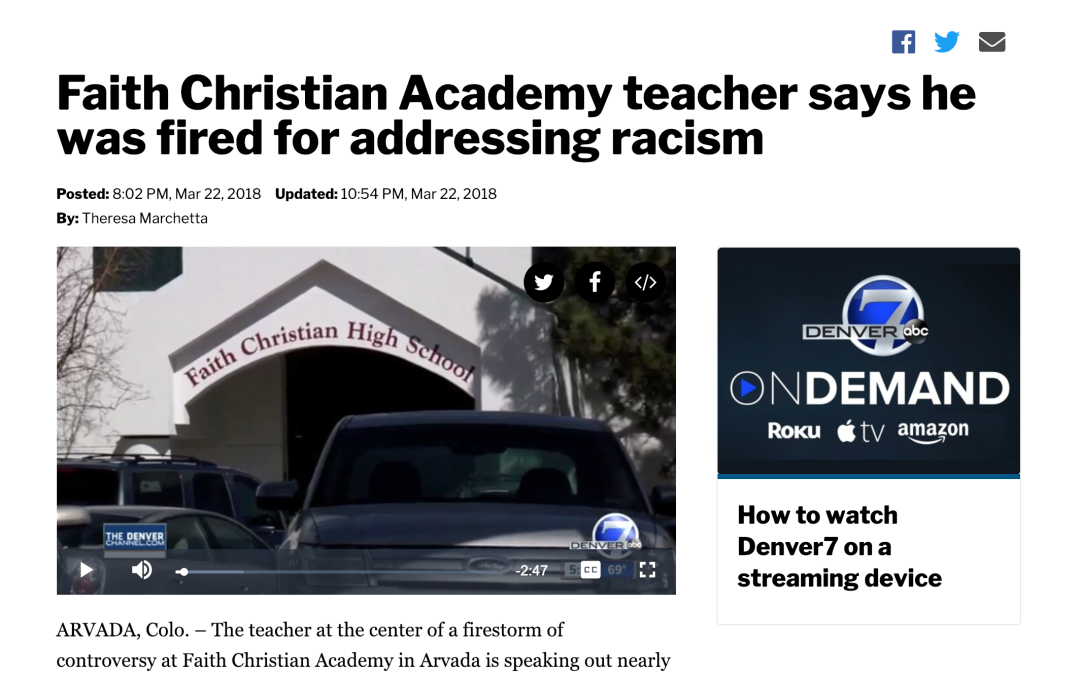On January 18, I launched the hashtag #ExposeChristianSchools on Twitter as a response to Vice President Mike Pence and conservative commentators like David French lambasting liberals over legitimate criticism of Second Lady Karen Pence for choosing to teach art at Immanuel Christian School in Springfield, Virginia—a K-8 school that explicitly discriminates against members of the LGBTQ community. As a queer graduate of a similar evangelical school, Heritage Christian School in Indianapolis, Indiana, I have things to say about how indoctrination in hardline right-wing ideology and biblical literalism traumatized me.
As it turns out, a lot of other people do too. #ExposeChristianSchools went viral organically, as numerous Twitter users who attended Christian schools or were homeschooled with fundamentalist curricula spoke up about misogynistic dress codes and creepy skirt checks, sex education that was nonexistent or consisted of fear mongering and shaming, “slave auction” fundraisers, discrimination against members of the LGBTQ community and people of color, corporal punishment, and being taught alternative facts, for example that the Loch Ness Monster is real and proves that humans and dinosaurs lived at the same time. Many people mentioned that over a decade later they are still making up for gaps in their knowledge. Teachers and former teachers weighed in as well, talking about how they chafed at enforced patriarchal strictures or how they were exploited to work for poverty wages. Tweets with the hashtag number in the hundreds of thousands.
As I write this, however, if you were to judge the #ExposeChristianSchools phenomenon from the top Google search results taken at face value, you would believe that Christian schools are just fine and far better than public schools thank-you-very-much, that a “mob” of “angry leftists” representing an emerging “anti-Christian” “white progressive populism” is “attacking Christianity,” and, what’s more, a “nefarious” Jewish journalist from The New York Times, who may or may not have created the hashtag, has been fishing for demeaning statements about Christian schools in order to write a biased and inaccurate “fake news” hit piece out of his presumed anti-Christian animus. Warning: there anti-Semitic slurs, racist images, and hate speech in the illustrations below.
Having monitored the use of the hashtag and the clearly disingenuous and deliberately fantastical right-wing narrative that has formed around it over the last couple of weeks, I would like to set the record straight, and in the process to make a case for why responsible media outlets must allow legitimate criticism of white evangelicals—far and away America’s most nativist, pro-Trump demographic—to be heard. The flurry of right-wing efforts to control the narrative on #ExposeChristianSchools provides a case study in the production of disinformation or “fake news,” a serious problem that exploits social media outlets like Facebook and Twitter, both of which have been slow to address it.
In most of the coverage of the hashtag in outlets like The New York Post, Pat Robertson’s Christian Broadcasting Network, Townhall, The Daily Wire, and National Review, I am not mentioned as the hashtag’s creator. Tucker Carlson’s The Daily Caller and Breitbart both refer to me as having claimed to create the hashtag (neither reached out to me), insinuating that it may have conspiratorial origins as an organized “hit job.” With the exception of relatively late coverage from The Associated Press, thus far only more niche outlets, like The Daily Dot and Paper Magazine have done due diligence and reported on the hashtag as what it is—a grassroots critique of the oppressive cisheteropatriarchal, white supremacist ethos that characterizes fundamentalist and evangelical schools, as well as some Catholic and mainline schools. And a critique that is being made by people who attended the schools in question–people who are erased in the right-wing narrative.
Dan Levin’s piece finally broke on January 29, well after the right-wing media generated a false narrative about it, and the story focuses at least as much on people’s self-described positive experiences in Christian schools as on negative experiences, and does not undertake a still much needed deep dive into Christian schools’ systemic problems. The positive descriptions of Christian school experiences that popped up in response to Levin soliciting stories related to the viral #ExposeChristianSchools phenomenon were generally very vague, whereas those using the hashtag as it was originally intended to be used often get very, very specific. That is telling and should be noted. Meanwhile, the American public needs to understand how internet trolls and right-wing authoritarians attempted–with a significant degree of success–to hijack an important discussion.
The advent of social media was initially hailed as a democratizing force. That it has the potential to be so is shown in the initial success of #ExposeChristianSchools, through which the often ignored voices of people like former evangelicals, often referred to as “exvangelicals” or “exvies,” could catch the attention of the general public with our concerns. Horror stories told by one of us might be dismissed as representing the “fringe” of evangelicalism or the result of “a few bad apples,” but it is far more difficult to treat tens of thousands of people who are insisting that the issues are systemic the same way.
The radical Right is aware of this, of course, and as #ExposeChristianSchools hit around 20k tweets and entered Twitter’s top trends on the night of January 18 to January 19, trolls began to plot their pushback on 4chan, floating talking points about “anti-Christian bigotry” and alternative hashtags such as #ExposeMuslimSchools and #ExposePublicSchools. All hell broke loose when the video of the Covington Catholic boys taunting Indigenous Elder Nathan Phillips dropped on January 19, and #ExposeChristianSchools tweets zoomed into the hundreds of thousands, with some confusion caused by what seemed to some to be the conflation of all kinds of Christian schools, including Catholic schools, under a hashtag originally meant to take aim at evangelical schools, which tend to call themselves “Christian schools” or “Christian academies.” Catholic schools vary widely in a way that evangelical schools do not, and as the right-wing outrage machine rushed to the defense of the Covington boys, many Twitter users apparently concluded that the hashtag started to call attention to their behavior. Right-wingers worked to stoke the confusion, and the talking points that originated on 4chan hit productions like Fox & Friends and hardline Catholic commentator Matt Walsh’s podcast.
And then, on January 24, New York Times youth reporter Dan Levin entered the picture. He reached out to me, explaining that he wanted to do a piece on the #ExposeChristianSchools phenomenon, as it had opened his eyes to realities of fundamentalism and evangelicalism that he was unaware of. A hashtag addressing a hot-button social issue that has accumulated hundreds of thousands of tweets is certainly newsworthy, and I was, and am, very pleased at getting the opportunity to have exvangelical concerns highlighted in a prominent paper whose religion reporting tends to be unduly friendly to evangelicals. Dan asked if I could introduce him to other Christian school alumni to talk to. I did so, but I also suggested he put out a tweet calling for responses, a perfectly normal journalistic practice these days. Neither Dan nor I was prepared for what followed. Within seconds of tweeting “I’m a New York Times reporter writing about #exposechristianschools. Are you in your 20s or younger who went to a Christian school? I’d like to hear about your experience and its impact on your life. Please DM me,” Dan was bombarded with accusations of bigotry against Christians. His tweet received over 10,000 replies, most of them singing the praises of Christian schools, and some of them explicitly anti-Semitic. A Google search was all it took to confirm that, once again, the troll infestation originated on 4chan. And once again, the right-wing outrage machine was off and running, twisting the meaning of Dan’s tweet into a plot to defame Christians as opposed to what it was: a legitimate request for sources to contribute to his reporting on a newsworthy organic hashtag campaign and the people behind it.


We could draw a number of morals from this story, but I’d like to focus on this one. While the vicious attacks on Dan Levin illustrate one reason that responsible journalists and news outlets may be reluctant to criticize any large group of American Christians, their failure to do so has consequences. For too long, the voices of those harmed and marginalized by the Christian Right, including and even especially those of us who grew up as the Christian Right and came out traumatized, have gone unheard. When we begin to break through using social media, if major news outlets refuse to cover us while the Right goes into overdrive to manufacture a false narrative, those major news outlets are complicit in silencing us and in allowing that false narrative to flourish. And that false right-wing narrative continues to do damage. On February 1, Religion News Service published a piece by Jacob Lupfer that parrots the false narrative, exhibits no due diligence, and erases survivors of authoritarianism and abuse. This is extremely disappointing for an outlet that is supposed to be engaged in legitimate religion journalism.
White evangelicals are not monolithic, but they are overwhelmingly an authoritarian demographic, currently empowered under Trump and representing a real threat to democracy and civil rights in America. It is high time for exvangelicals to be given a place in our national discussions of evangelicalism. Major media outlets need to do better.


I remember when I was 15, I went to a Christian School in Santa Maria California that was run by the SBC (Southern Baptist Church) it was 2007-2008 when it was happening. I witnessed a lot of verbal abuse coming from a teacher, and even I had my own experience of verbal abuse. Not to mention, I was written up on a daily basis. I’ve since been diagnosed at 18 with a anxiety disorder, and I’ve even told doctors and therapists that I’ve seen about what kind of things they did against me at the Christian school (Valley Christian) and I even had had some low-confidence. Furthermore, I’m autistic. So, yeah #exposechristianschools
LikeLike